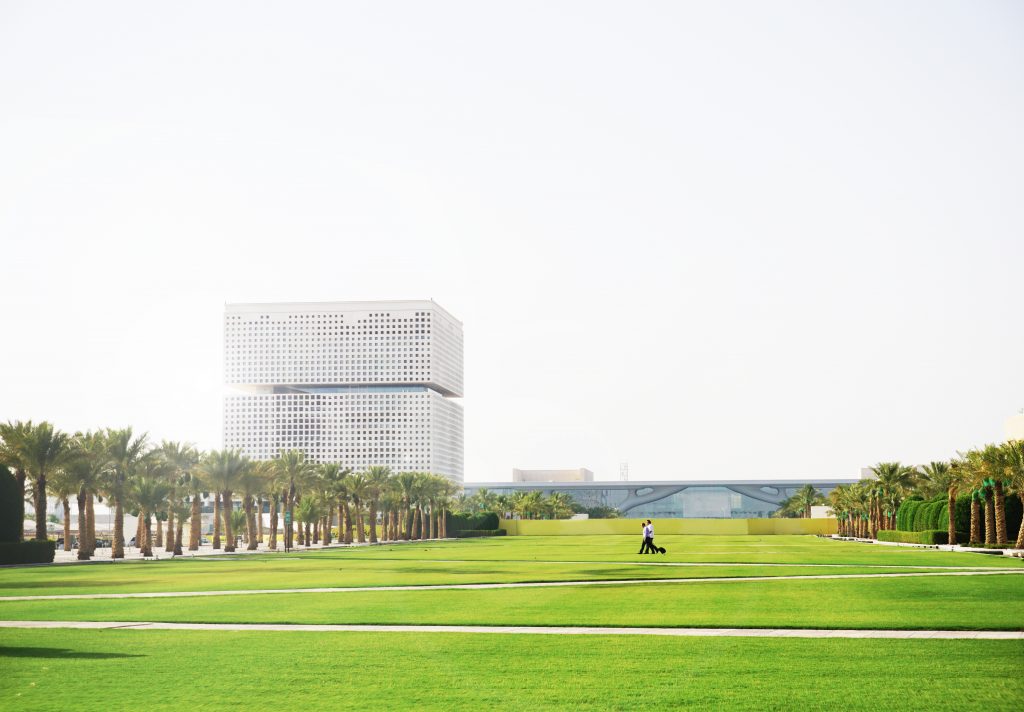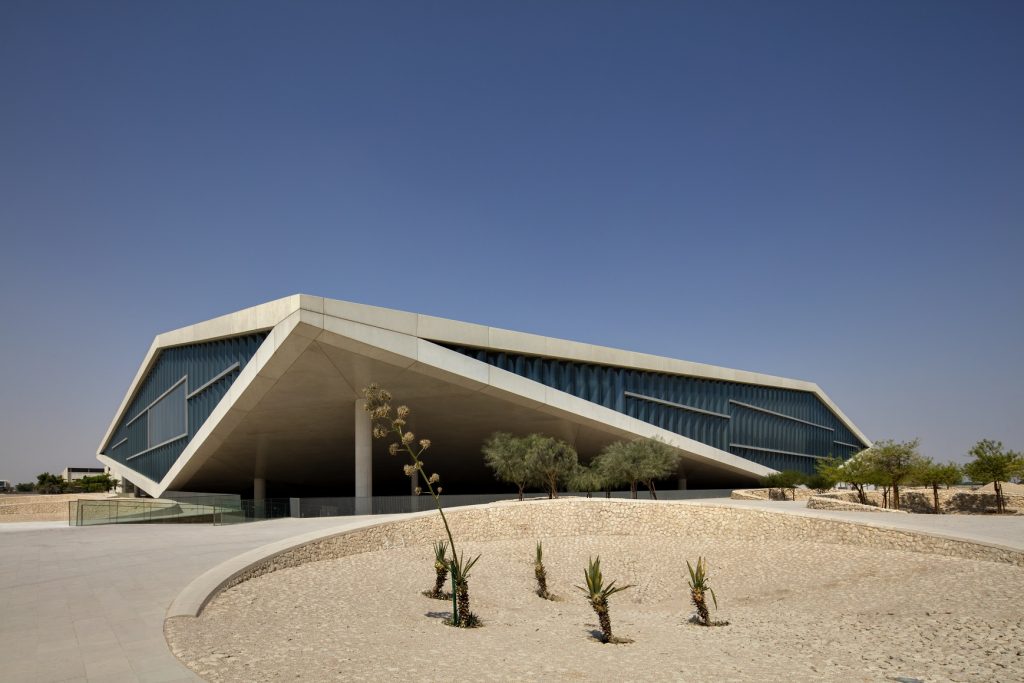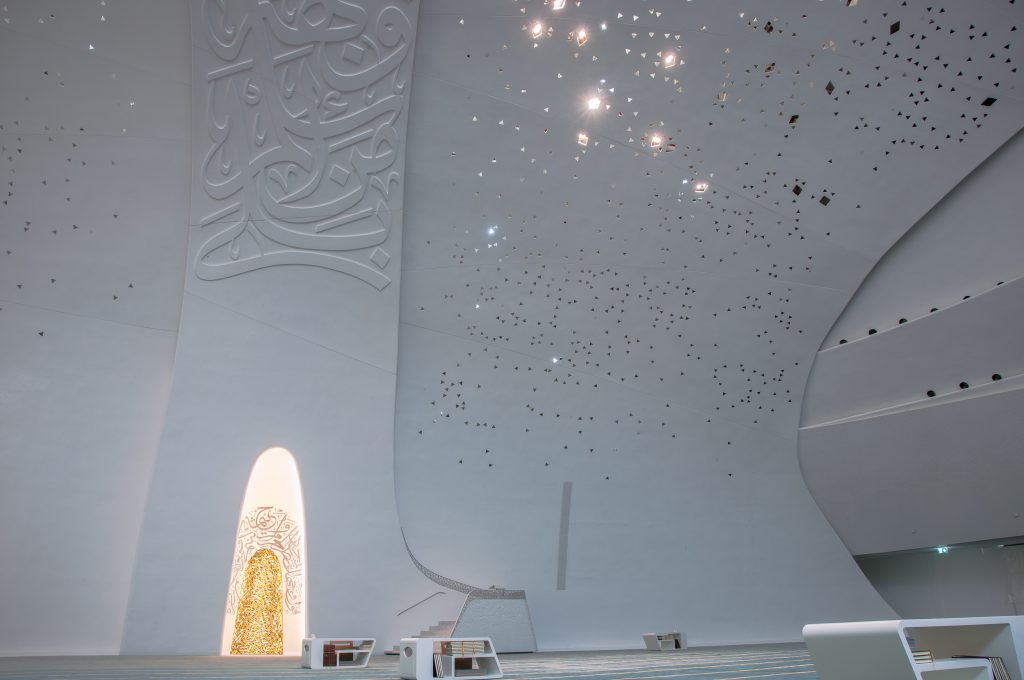The moment you enter Education City in Doha it radiates a sense of balance. The newly constructed sleek buildings blend harmoniously with the natural desert environment– all showcasing the latest technology and innovative designs in their architecture. The master plan for Education City was designed by renowned architect, Arata Isozaki who is known to bring his Japanese influence into his work.
The micro-city includes institutions like Carnegie Mellon, Georgetown University, HEC Paris in Qatar and many other well-known academic brands, each school adding a specific focus into the City’s greater ecosystem. For instance, the prestigious Weill Cornell Medical College in Qatar has produced about 335 graduates all experiencing rigorous training to earn a Cornell University MD degree. Just across the way, is a state-of-the-art facility called Sidra Hospital providing world-class healthcare to families, a biomedical research institute established to tackle diseases and Qatar Diabetes Association, helping to raise awareness for diabetes. Nearly a quarter of those graduates are working or continuing their training as residents at the affiliated hospitals in Qatar.
The institutions also stress a practical experience for students. We caught up with Miss Ruba Shaath, an assistance producer at Al Jazeera. As a graduate of Northwestern University in Doha, she had the opportunity through her school to intern at the Huffington Post office in New York City. “My journalism residency was stimulating and inspiring. Living in New York was an experience in itself. At work, I was meeting with prominent people and interacting with celebrities. I learned what it was truly like to work in broadcast, from my peers at HuffPost Live. I still keep in touch with my peers and mentors who taught me so much.”
The vision for Education City began with HH Sheikha Mozah bint Nasser, Chairperson of Qatar Foundation for Education, Science and Community Development by fulfilling a personal need of the Sheikha–she simply wanted the best education for her children and thus began the Qatar Academy in Doha, a school that provides Qatar with a high quality bi-lingual education in English and Arabic. Her Highness’ overall mission lead to forming the Qatar Foundation that trains students to become Qatar’s future leaders.
Female Leadership
Currently under the direction of HE Sheikha Hind bint Hamad Al Thani as CEO, Qatar Foundation has roughly around 50% female employees, and 5 out of the 12 in management positions are women.
We met with the dynamic Mrs. Machaille Hassan Al-Naimi, President of Community Development, who plays a critical role in enriching the social and economic prosperity of the people of Qatar. Her Georgetown-meets-Qatar-style is hard to miss as we jump right into the exciting new projects the foundation is executing.
Mrs. Al-Naimi shares the ethos that is embedded in each project, “Qatar Foundation is unique, there is no other organization in the region that is doing the work we do. We are creating a culture that is equally nurturing for both the expat and Qatari communities.” Just as the organization does with its physical structures, the programs also are designed to strike a balance between the varying groups in Qatari society.
Qatar National Library
At the heart of Education City lies the 45,000 square meter and Rem Koolhaas-designed Qatar National Library. Made to resemble two pieces of paper that are pulled apart and folded diagonally at the corners to create a shell-like structure, the formation of an open space highlights a panoramic view of books.
Dr. Stuart Hamilton, Deputy Executive Director of Qatar National Library says, “The library isn’t a dark place with quiet nooks, instead it’s an open space which can be used in a number of creative ways to encourage different experiences. The building itself calls for the implementation of new innovative programs for its users, and we are opening up all the library’s spaces to the public so they can make the most of their ideas.”
Inside the library there’s a restaurant that gives visitors a chance to take a break. In the upcoming months, the space hopes to host food bloggers to encourage the community at large to engage in the dynamic programs at the Library.
Dr. Hamilton continues, “We are changing the very concept of what a library is and what it can offer to the community, with our special events area hosting the Qatar Philharmonic Orchestra each month, games being played on our interactive screens, while at the same time researchers and students carry out their work in our quiet study areas.”
The open space lends itself to having its own segregated areas of work stations. What’s unique about the library space is welcoming visitors at the entrance is a café offering pistachio flavored lattes and biscuits for young children. The library overall has a unique vibe.
A focal point of the building is the Heritage Library meant to reflect the legacy of Arab civilization. Designed as an excavation site, its growing collection includes rare and valuable archival documents, books and periodicals in various European languages; early Arabic printed materials, such as books, journals, magazines and newspapers; and Arabic manuscripts, maps, atlases, globes, historical photographs, and tools related to travel.
Visitors can request access to all these materials with the help of a librarian prepared to help at any time–a rare treat for someone visiting.
On the date of our arrival, the library opened exactly one year ago. Back in April of this year, at the inauguration, HH the Emir Tamim bin Hamad Al Thani, placed the millionth book on a shelf at the library, himself, indicating the official launch of this vibrant community center.
Education City Mosque
The National Library may lie at the heart of Education City, but the Education City Mosque is certainly its soul. The striking interpretations of traditional structures are designed by Mangera Yvars Architects, as a contemporary reinterpretation of the model of a madrasa. Its twin ribbons – rising skywards and pointing toward Makkah, while also intertwining to create the structure’s internal spaces – are emblematic of knowledge and enlightenment.
The College of Islamic Studies Building and Education City Mosque recall the original purpose of mosques to be centers of learning and community gathering points and not just a place of worship. The design was conceived around the idea that “knowledge equals light,” with the college equated with ‘knowledge’ and the mosque equated with ‘light.’
Ramadan nights are popular at the mosque with visitors spilling out into the courtyard because of the crowds. In the evening the ceiling of the mosque lights up to resemble the stars—creating a serene space for guests.
Five large columns, representing the five pillars of Islam, are the foundation of the Education City Mosque, each bearing a verse from the Holy Qur’an. Through framing of natural light, it channels the cornerstones of Islamic and Arabic heritage into a masterpiece of modernity.
Lastly, the ablution areas are located around a cascade inspired by the concept of the four rivers of Paradise, marking the beginning of the four streams that run through the building and continue into its landscape.
The mosque has gained international recognition with young professional Muslims across the globe not just because of its thoughtful design but because of the outstanding Friday sermons (khutbah) and general Islamic lectures open to the community. Renowned scholars like: Dr. Mohammed Rateb Al-Nabulsi from Syria, and Dr. Omar Abdelkafy from Egypt have graced the minbar.
Mrs. Arshe Ahmed, Executive Director at Medina Community Clinic, and volunteer with the Princeton Muslim Life Program at Princeton University in New Jersey fondly remembers her visit to the mosque, “The architecture of the prayer space connected the worshipper to the celestial—it was breathtakingly beautiful. There was thoughtful architecture throughout the grounds and it revived the beauty and splendor of Islamic civilization.”
The mosque for young Muslims– is the hub for an Islam that represents their core beliefs.
On occasion, you might find HH Sheikha Mozah herself, offering her prayers in the ample sized ladies section of the mosque—a refreshing accommodation given the fact that some mosques don’t have spaces allotted for women.
Future
Another new project that just launched in Education City is a new skate park. Young students who have just gotten out from nearby schools are strapping on their knee pads and helmets to start skateboarding while others ride their bikes—a great scene to witness as the call to prayer is announced in the background.
This dichotomy depicts a new balance the Qatar Foundation has defined for the Arab and Muslim world. Just as the architecture blends in with the desert at Education City, the Foundation has created an inherent educational system that strikes a balance between tradition and modernity, East and West, Qatar and the global community.
Back at the Qatar Foundation headquarters, as we walk through the glass hallways, the open floor plan concept is resonant of Silicon Valley’s top firms like Facebook. We can’t help but hope for a chance encounter with HH Sheikha Mozah, a visionary who began this amazing journey to provide the best educational experience to a nation.






















My kids study at one of the schools at QF and we love it. There’s a cool mix with both local and international students. That’s exactly the type of upbringing I want them to have.